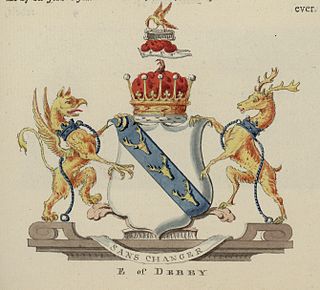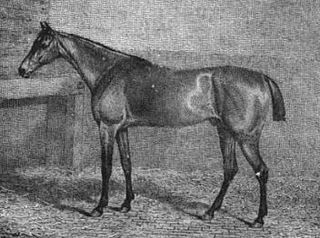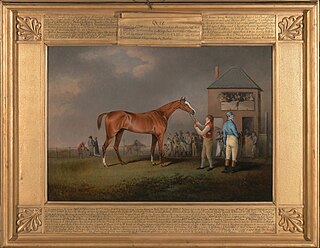Related Research Articles

The Grand National is a National Hunt horse race held annually at Aintree Racecourse in Aintree, Merseyside, England. First run in 1839, it is a handicap steeplechase over an official distance of about 4 miles and 2½ furlongs, with horses jumping 30 fences over two laps. It is the most valuable jump race in Europe, with a prize fund of £1 million in 2017. An event that is prominent in British culture, the race is popular amongst many people who do not normally watch or bet on horse racing at other times of the year.

Speen is a village and civil parish in West Berkshire, England. Centred 2 miles (3 km) north west of the largest town in the district, Newbury, Speen has clustered settlements, the largest of which is Speen village, which is contiguous with Newbury, and the others, buffered from the town by the A34 road, are Bagnor, Stockcross, Woodspeen and Marsh Benham. Its other land is an approximately even mixture of woodland and agricultural fields including hay meadows for livestock feed and pasture. The area varies greatly in elevation, having the Reading to Taunton Line alongside the north bank of the River Kennet as its southern boundary and both banks of the River Lambourn in its north with elevated ground in between. Benham Park in the south-west of the area is a listed landscape garden and house.

Hull Kingston Rovers are a professional rugby league club based in Kingston upon Hull, Yorkshire, England. The club play home games at Craven Park and compete in Super League, the top tier of British rugby league.

Lambourn is a village and civil parish in Berkshire, England. It lies just north of the M4 Motorway between Swindon and Newbury, and borders Wiltshire to the west and Oxfordshire to the north. After Newmarket it is the largest centre of racehorse training in England, and is home to a rehabilitation centre for injured jockeys, an equine hospital, and several leading jockeys and trainers. To the north of the village are the prehistoric Seven Barrows and the nearby long barrow. In 2004 the Crow Down Hoard was found close to the village.

Stockwell (1849–1870) was a British Thoroughbred racehorse and a Leading sire in Great Britain & Ireland seven times; he was second on the sires' list a further four times during a 14-year period.

Edward Richard William Stanley, 19th Earl of Derby, is a British hereditary peer and landowner.
The 1841 Grand Liverpool Steeplechase was the third official annual running of a steeplechase, later to become known as the Grand National Steeplechase handicap horse race which took place at Aintree Racecourse near Liverpool on 3 March 1841 and attracted a then smallest ever field of 11 runners.

Bay Middleton was an undefeated Thoroughbred racehorse whose victories included two British Classic Races. He was twice the Leading sire in Great Britain and Ireland.
Michael Fitzgerald is a retired Irish National Hunt jockey and current television racing pundit. Fitzgerald rode for the majority of his career in Great Britain and less often Ireland.

Jennifer Susan Pitman OBE is a British former racehorse trainer and author. She became the first woman to train a Grand National winner when Corbiere won the race in 1983, and she won a second Grand National with Royal Athlete in 1995. She has also trained two Cheltenham Gold Cup winners with Burrough Hill Lad in 1984 and Garrison Savanah in 1991. Following her retirement from horse training in 1998, she became a writer of novels, principally with a racing theme. She is a member of the Disciplinary Panel and Licensing Committee of the British Horseracing Authority.
Corbiere (1975–1988) was the racehorse which won the Grand National in 1983. In training Corbiere was also known as Corky.

The 1995 Grand National was the 148th official renewal of the famous Grand National steeplechase that took place at Aintree near Liverpool, England, on 8 April 1995.

Attila (1839–1846) was a British Thoroughbred racehorse and sire. In a career that lasted from August 1841 to June 1844 he ran thirteen times and won eight races. He began his career with a run of six successive wins, culminating in the 1843 Derby. His later form was disappointing and he never won another competitive race: his two subsequent "victories" were the result of walkovers in races in which he was unopposed. He had little chance to prove himself as a stallion as he died at the age of seven from injuries sustained in an accident on board a ship in the English Channel.
Cedric was a British Thoroughbred racehorse. In a career that lasted from April 1824 to August 1826 he ran eleven times and won eight races. Cedric was unraced as a two-year-old, but in 1824 he proved himself the best British colt of his generation by winning seven of his eight races including The Derby and the Grand Duke Michael Stakes. After winning a notable match on his first run as a four-year-old he lost his form and was well beaten in his remaining races. He was retired to stud at the end of 1826 but proved to be completely infertile.

Blucher (1811–1841) was a British Thoroughbred racehorse and sire named after the Prussian General Gebhard Leberecht von Blücher, one of the most successful commanders of the Napoleonic Wars, but his name was invariably spelt without the umlaut.

Quiz (1798–1826) was a British Thoroughbred racehorse and sire best known for winning the classic St Leger Stakes in 1801. Quiz was a durable, top-class performer, winning at least once a year in racing career which lasted seven seasons from August 1801 until April 1807. Apart from the St Leger he won many other important races including three Brocket Hall Gold Cups, two Oatlands Stakes at Newmarket Racecourse, a Great Subscription Purse at York, a King's Plate and the Jockey Club Plate. In all he won twenty-one times in thirty-six races for four different owners before being retired to stud, one of which was Mr Hallett Esq, where he proved to be a successful sire of winners.

Charles the Twelfth (1836–1859) was a British Thoroughbred racehorse and sire best known for winning the classic St Leger Stakes in 1839. He ran a dead-heat with Euclid in the classic before winning the prize in a deciding heat.
Oliver Martin Carwardine Sherwood is a British horse trainer who specialises in training horses that compete in National Hunt racing.
Mont Tremblant was a French-bred, British-trained Thoroughbred racehorse who won the 1952 Cheltenham Gold Cup. Originally trained in France, he was switched to a British stable and made an immediate impact, defeating a strong field to win the Gold Cup as a six-year-old. In the following season he finished third in the King George VI Chase and fourth in the Gold Cup before producing arguably his best performance by running second under top weight in the Grand National. His later career was repeatedly interrupted by injury.
Sir Frederick Johnstone, 7th Baronet (1810–1841) was a Member of Parliament (MP) for Weymouth and Melcombe Regis from 1832 to 1835. He was part of the Johnstone baronets family.
References
- 1 2 Wright, Chris (3 May 2013). "GRAND NATIONAL SPECIAL: From 1841 to 2001 - a look back at the winners when the year ends in a one". Liverpool Echo. Retrieved 7 November 2024.
- ↑ "History of Horse Racing in Lambourn | Lambourn". lambourn.org. Retrieved 7 November 2024.
- ↑ "Grand National Facts Figures". www.thejockeyclub.co.uk. Retrieved 7 November 2024.
- ↑ Sargeant, Karen (2 February 2022). "Timeline: Grand National's most historic moments – part 1". Eclipse Magazine. Retrieved 7 November 2024.